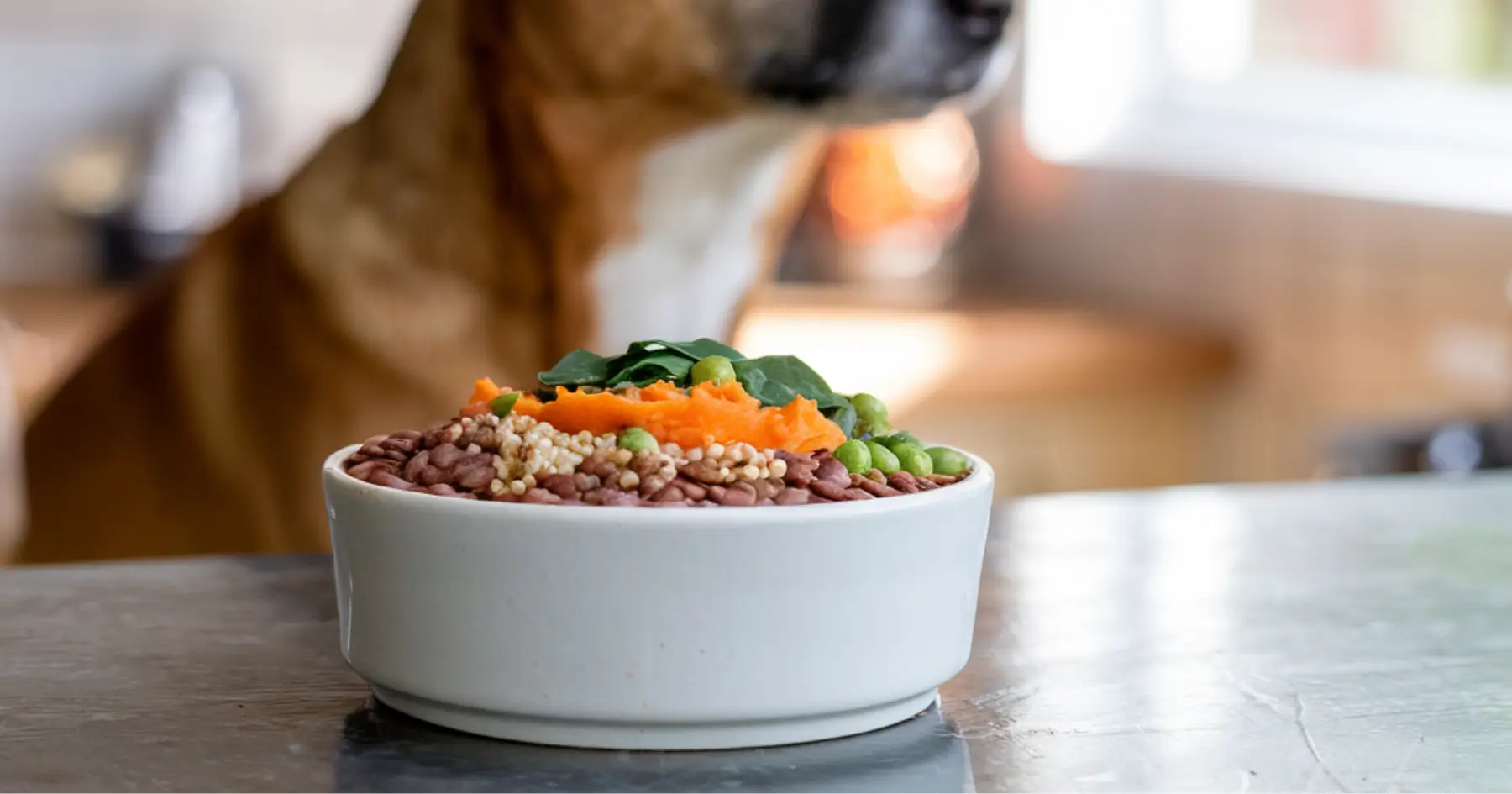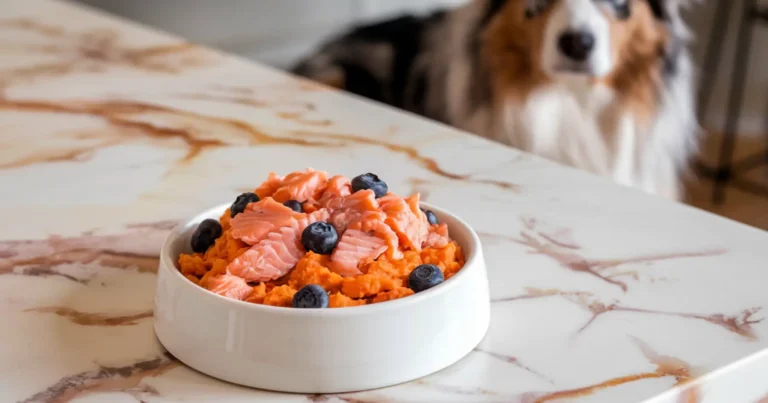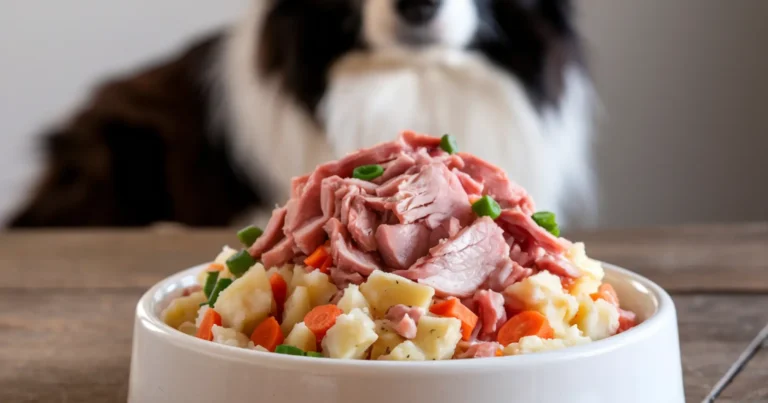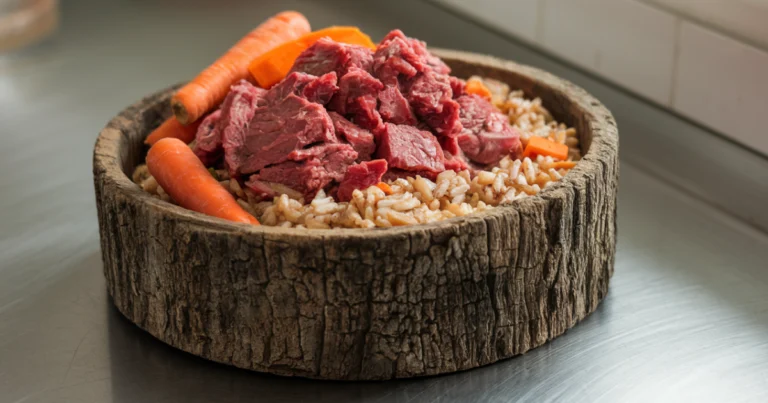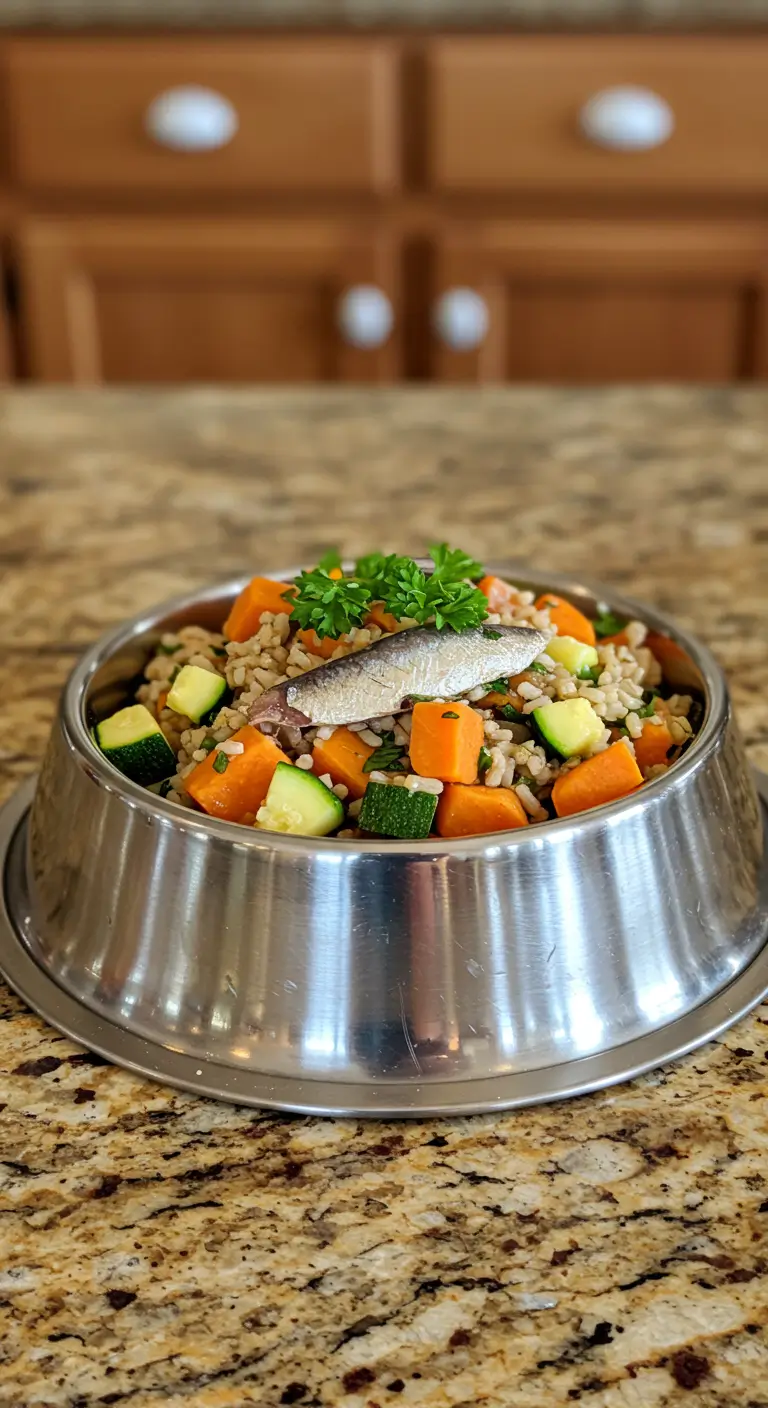Vegan Dog Food Recipe for Skin Allergies: 5 Easy Steps
What’s up, dog lovers! Is your precious pup scratching itself raw despite trying every single protein under the sun? I feel your frustration completely. Sometimes when you’ve exhausted chicken, beef, lamb, fish, and even exotic proteins like venison, you start wondering if there’s anything left to try.
Well, here’s something that might surprise you – a vegan dog food recipe could actually be the game-changer you never saw coming. Before you roll your eyes, I’m not talking about some Instagram trend. This plant-based dog food approach has genuinely helped some of the most challenging skin allergy cases in dogs when traditional proteins just weren’t cutting it.
This homemade vegetarian dog food is part of our comprehensive homemade dog food recipes for allergies series. When Benji’s friend Luna (yes, confusing names!) couldn’t tolerate ANY animal proteins, this vegetarian dog food recipe became her lifeline. Ready to explore this unexpected solution?
Table of Contents
Why Plant-Based Ingredients Can Soothe Severely Allergic Skin
Alright, let’s get real about this whole plant-based dog food thing. I know it sounds weird – dogs eating like vegetarians? But here’s what I’ve learned: when your pup is allergic to literally every protein you try, sometimes you need to think completely outside the box.
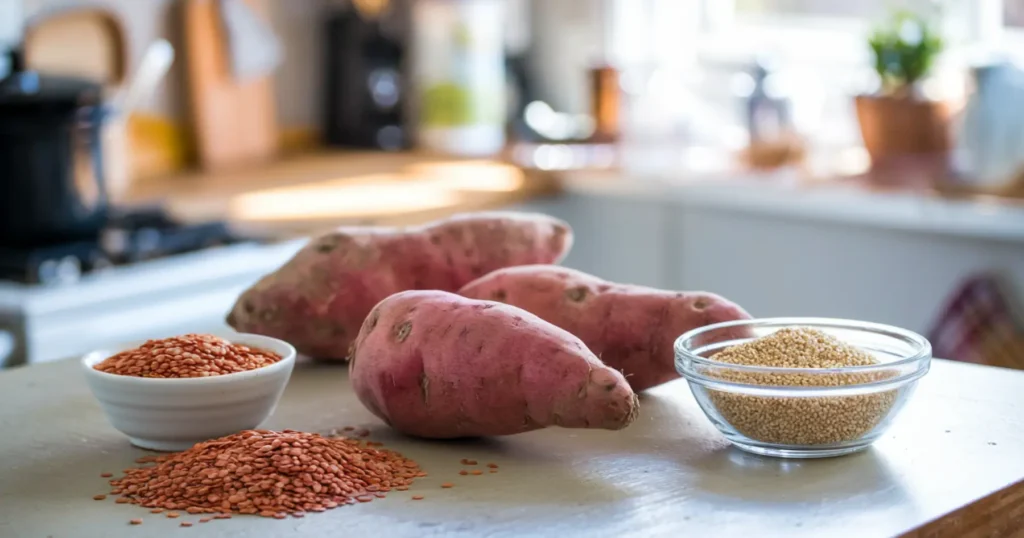
Understanding When Vegan Makes Sense for Dogs
Dogs aren’t actually true carnivores like cats – they’re omnivores who CAN process plant proteins effectively. The catch? It needs to be done absolutely correctly with proper veterinary oversight. This vegan dog food recipe isn’t about following trends; it’s about medical necessity for dogs’ skin allergies that won’t respond to anything else.
I’ve witnessed pups who developed reactions to every single animal protein – chicken, beef, lamb, duck, fish, you name it. When traditional novel proteins fail, carefully formulated homemade vegetarian dog food can provide relief while giving the immune system a complete break from triggering substances.
Plants like lentils deliver complete amino acid profiles without allergen risks. Sweet potatoes offer beta-carotene that actively supports skin healing. Quinoa offers all the necessary components for a healthy coat and skin renewal.. The anti-inflammatory compounds in these ingredients can actually calm irritated skin from within.
The Healing Power of Anti-Inflammatory Plant Foods
Plant-based dog food works for severe skin issues because it removes every possible animal protein trigger while flooding the system with healing compounds. Unlike our duck and potato options or salmon recipes, this approach eliminates ALL potential protein allergens.
But here’s the critical part – vegan dog food recipes require specific supplementation to meet nutritional needs. We’re talking essential amino acids, taurine for heart health, vitamin B12, and more. This isn’t something you improvise; it demands professional guidance.
Complete Plant-Based Formula for Allergic Skin Relief
Before diving into this homemade vegetarian dog food recipe, I cannot stress enough: consult a veterinary nutritionist if you plan long-term feeding. This formula works beautifully for elimination trials or short-term management while developing a comprehensive plan with your vet team.
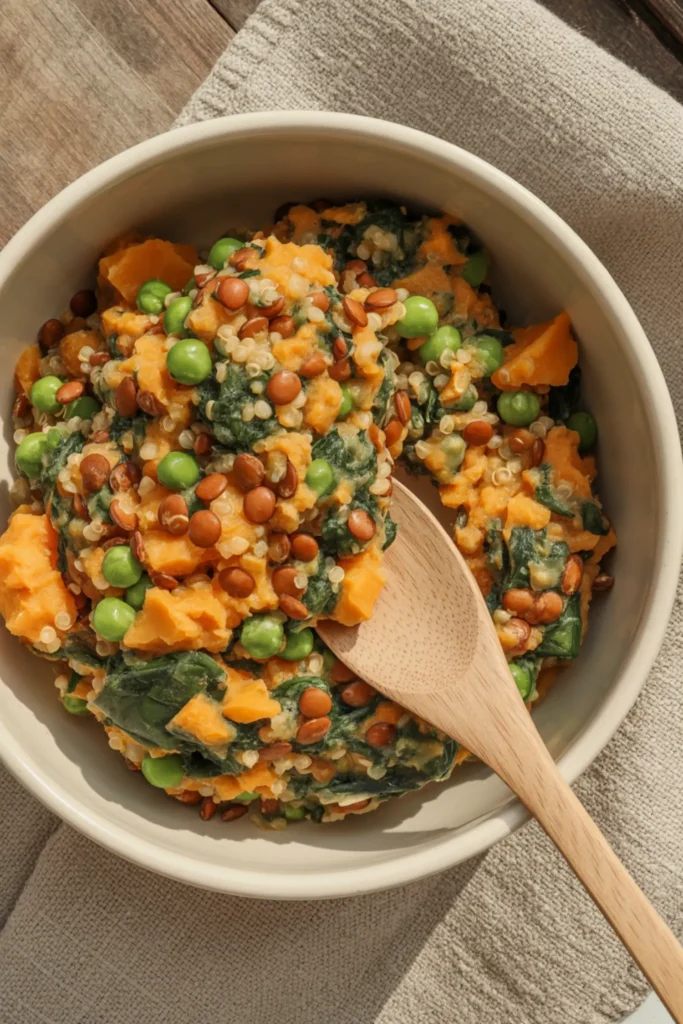
Recipe Overview
- Prep Duration: 20 minutes
- Cooking Duration: 40 minutes
- Complete Time: 60 minutes
- Recipe Yield: 5-7 cups (sufficient for 30-50 lb dogs for 3-4 days)
- Storage Life: Refrigerated 4 days, frozen 3 months
- Energy Content: Roughly 50-55 calories per ounce
Core Ingredients
| Component | Quantity | Skin-Healing Benefits |
|---|---|---|
| Dried red lentils | 1.5 cups | Plant-based complete protein, inflammation reduction |
| Fresh sweet potatoes | 2 large pieces | Beta-carotene for cellular repair, gentle carbohydrates |
| Rinsed quinoa | 1 cup uncooked | Complete amino acid spectrum, gluten-free energy |
| Fresh green peas | 1 cup | Additional plant protein, minimal allergy potential |
| Pure coconut oil | 3 tablespoons | Natural antimicrobial properties, healthy fats |
| Baby spinach leaves | 2 cups chopped | Antioxidants, vitamins, and mineral support |
Essential Equipment
- Large cooking pot with secure lid
- Medium-sized saucepan
- Fine-mesh rinsing strainer
- Quality knife and chopping board
- Masher or large fork
- Generous mixing bowl
- Airtight storage vessels
Nutritional Breakdown (Per Cup Serving)
- Protein Content: 10-12 grams
- Fat Content: 4-6 grams
- Carbohydrate Content: 20-25 grams
- Fiber Content: 6-8 grams
- Total Calories: 400-440
Critical Guidelines for Plant-Based Canine Nutrition
- Long-term feeding requires comprehensive nutrient supplementation
- Veterinary nutritionist consultation is essential for complete diet planning
- Close monitoring is necessary to prevent nutritional gaps
- Choose organic produce when your budget allows, to minimize chemical exposure
- Never attempt this with growing puppies without professional supervision
- Regular bloodwork is recommended to track health indicators
5 Detailed Steps for Creating This Healing Plant Recipe
Making this vegetarian dog food recipe isn’t complicated once you understand the process. The secret lies in ensuring everything becomes super digestible for sensitive digestive systems.
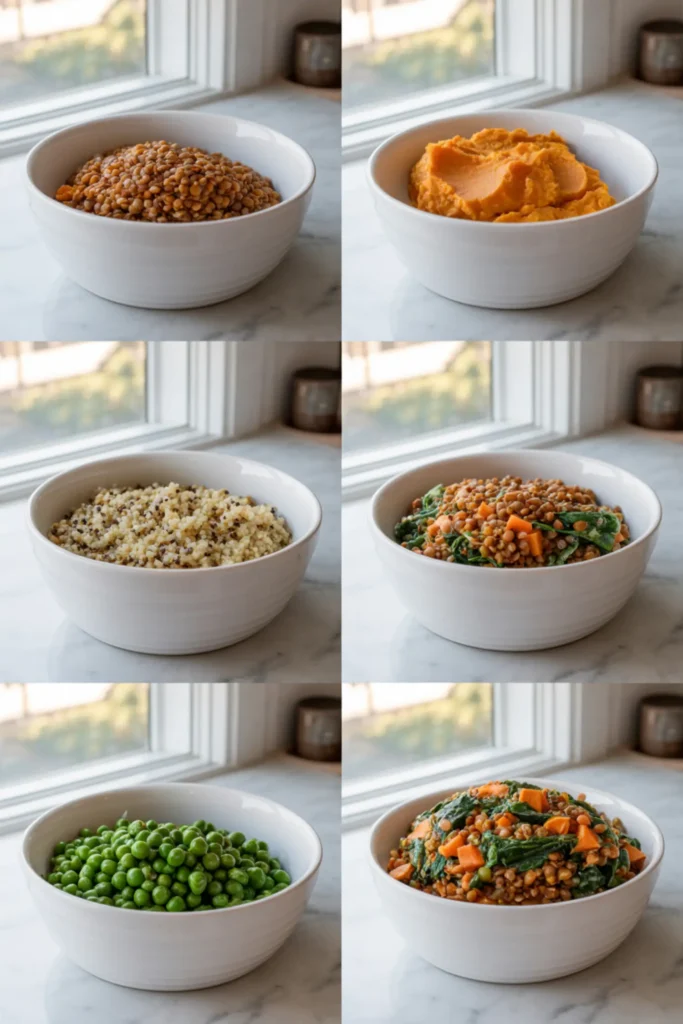
Step 1: Start with the Lentil Base
- Thoroughly rinse 1.5 cups of red lentils until the water becomes crystal clear
- Place rinsed lentils in a large pot with 4 cups of fresh water
- Reduce the heat to medium-low after bringing the mixture to a rolling boil.
- Allow to bubble gently, uncover for 15-20 minutes until lentils become very tender
- Red varieties break down more quickly than other lentil types
- Strain away any remaining liquid and set cooked lentils aside
Step 2: Process the Sweet Potato Components
- Scrub and peel sweet potatoes, discarding any imperfect areas
- Dice into uniform 1-inch pieces to ensure even cooking throughout
- Submerge in boiling water and cook 15-18 minutes until fork-tender
- Test doneness by easily piercing with a utensil
- Drain thoroughly and mash into a mostly smooth consistency with some texture
- Allow to cool while preparing other components
Step 3: Handle the Quinoa Preparation
- Rinse quinoa extensively under cold running water for 2-3 minutes
- Transfer to a medium saucepan with 2 cups of water
- Bring to vigorous boil, then reduce to lowest heat and cover tightly
- Simmer gently for 15 minutes until fluffy and the liquid disappears
- Remove from the heat source and rest covered for 5 minutes
- Fluff gently with a fork and set aside for cooling
Step 4: Prepare the Vegetable Components
- Steam green peas briefly for 3-4 minutes until bright emerald and tender
- Frozen peas simply need complete thawing without additional cooking
- Steam spinach leaves for 1-2 minutes, just until wilted
- Roughly chop cooled spinach into manageable pieces
- Avoid overcooking vegetables to preserve maximum nutritional value
Step 5: Final Assembly Process
- Combine cooked lentils and mashed sweet potato in a large mixing bowl
- Carefully fold in cooled quinoa without creating a mushy texture
- Incorporate steamed peas and chopped spinach throughout the mixture
- Add coconut oil while contents remain slightly warm for easy blending
- Mix everything thoroughly yet gently until evenly distributed
- Cool completely to room temperature before portioning or serving
Portion Guidelines and Plant-Based Diet Transition
Getting portions correct with this vegan dog food recipe becomes especially important since plant proteins are processed differently than animal-based options in canine digestive systems.
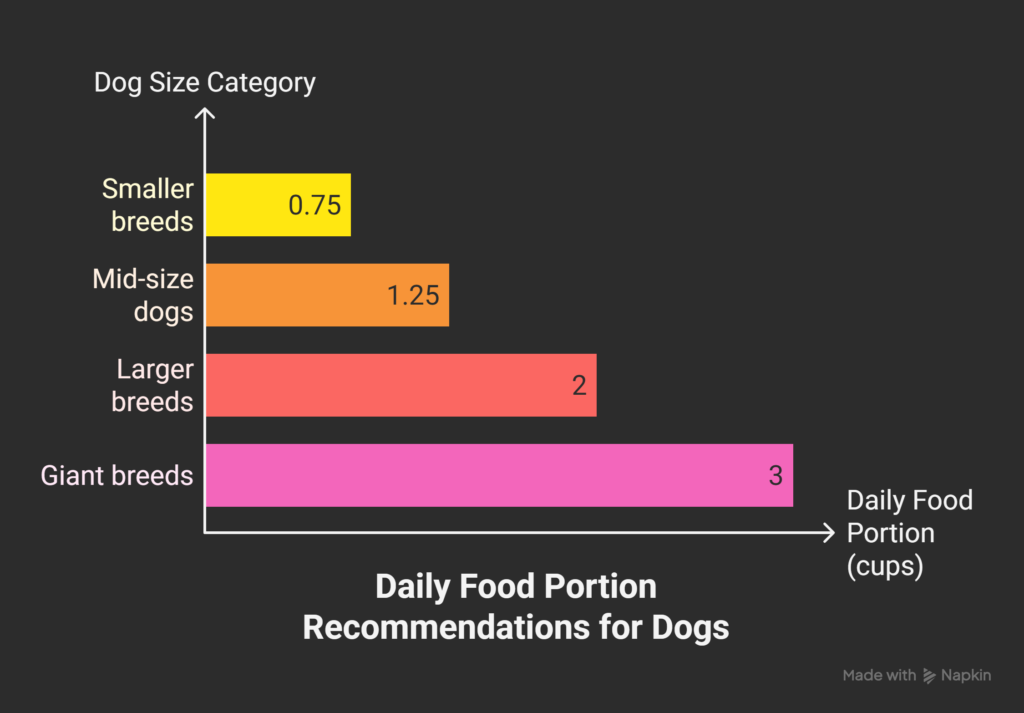
Daily Portion Recommendations by Size
- Smaller breeds (10-25 pounds): Approximately ½ to 1 cup daily
- Mid-size dogs (25-50 pounds): About 1 to 1.5 cups each day
- Larger breeds (50-75 pounds): Roughly 1.5 to 2.5 cups per day
- Giant breeds (75+ pounds): Around 2.5 to 3.5 cups daily
- Divide the total amount into 2-3 smaller feedings for optimal digestion
- Watch weight closely and modify portions based on individual response
- Plant-based meals may require increased volume to meet caloric requirements
Gradual Transition Strategy for Sensitive Systems
Switching to plant-based dog food demands extra patience since some pups adapt quickly while others need extended adjustment periods for different protein sources.
- Initial phase (Days 1-4): Mix 25% new formula with 75% current diet
- Second phase (Days 5-8): Increase to 50% new food, 50% familiar food
- Third phase (Days 9-12): Progress to 75% new recipe, 25% old diet
- Final phase (Days 13+): Complete transition to 100% plant-based nutrition
- Monitor for digestive changes and extend the timeline if necessary
- Some dogs require 3-4 weeks for complete dietary adjustment
- Try warming slightly or adding vegetable broth if initial refusal occurs
Tracking Your Dog’s Response to Plant-Based Nutrition
When implementing homemade vegetarian dog food for dogs’ skin allergies, careful observation becomes essential for measuring success and identifying potential concerns.

Positive Changes to Observe
- Notable reduction in scratching intensity and frequency
- Decreased paw licking and skin chewing behaviors
- Improved coat shine and overall texture quality
- Healing of inflamed skin areas and hot spots
- Enhanced energy levels without discomfort distractions
- More regular, comfortable bowel movements
- Reduced ear scratching or head shaking episodes
- Calmer, more restful sleep patterns without interruption
Expected Timeline for Skin Improvement
Compared to straightforward protein replacements, plant-based dog food skin healing frequently occurs more slowly. Here’s what to reasonably anticipate:
- Initial weeks (1-2): Digestive system adjustment period, minimal skin changes expected.
- Early improvement (3-4 weeks): First signs of reduced scratching intensity
- Significant progress (5-8 weeks): Notable improvement in skin condition and comfort
- Optimal results (8-12 weeks): Complete healing and maximum skin health if diet proves effective
Concerning Symptoms Requiring Professional Attention
- Deteriorating skin condition or emergence of new irritated areas
- Persistent digestive problems beyond the initial adjustment week
- Decreased energy or enthusiasm levels (potential nutritional deficiency indicators)
- Unexplained weight loss or declining body condition
- Signs of nutrient deficiencies, like coat dullness or lethargy
- Food refusal lasting longer than 24 hours
- Immediately contact the veterinary team if any concerning symptoms develop
Alternative Approaches for Severe Allergy Cases
Sometimes, even this carefully crafted plant based dog food may not provide the perfect solution. Don’t lose hope – additional options exist for extremely sensitive dogs.
Exploring Other Limited Ingredient Strategies
If plant-based nutrition isn’t delivering expected results, consider returning to single novel protein approaches. Some dogs respond wonderfully to turkey and quinoa formulations or lamb and rice combinations featured in our other guides.
Success often comes from discovering that single protein or carbohydrate source that doesn’t activate your dog’s immune system. Sometimes the journey requires testing multiple different approaches before finding the winning combination.
Considering Professional Therapeutic Diet Options
For dogs with the most stubborn skin allergies, veterinarians may suggest hydrolyzed protein formulations where proteins are broken into particles too small for immune system recognition. These prescription diets can prove remarkably effective for the most challenging cases.
Supporting Your Dog’s Recovery with Additional Care
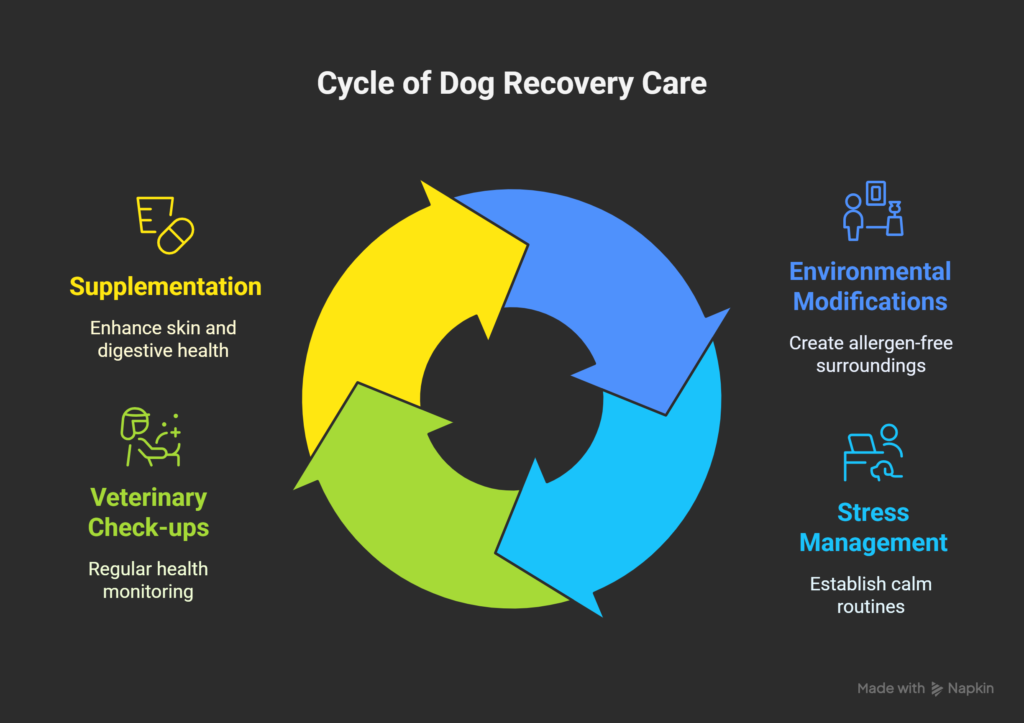
In addition to this vegan dog food recipe, there are a few other methods that can hasten skin healing and improve comfort levels.
Environmental and Lifestyle Modifications
Maintain your dog’s surroundings as allergen-free as possible throughout the healing journey. Choose hypoallergenic bedding materials, eliminate harsh cleaning products, and consider air filtration systems if environmental triggers also contribute to problems.
Stress significantly impacts dogs skin allergies, so establish calm, predictable daily routines. Moderate exercise benefits healing, but avoid activities causing overheating and increased scratching urges.
Collaborating with Your Veterinary Team
Regular veterinary check-ups become absolutely critical when feeding homemade vegetarian dog food. Your vet will monitor overall health status, body condition, and may recommend blood testing to screen for nutritional imbalances.
Ask about supplements supporting skin barrier function, such as algae-derived omega-3s, probiotics for digestive health, or specific vitamins enhancing skin recovery processes.
Essential Success Factors for Vegan Dog Nutrition
- Vegan dog food recipes can effectively address severe skin allergies when properly formulated and professionally supervised
- This plant based dog food method eliminates ALL potential animal protein triggers simultaneously
- Homemade vegetarian dog food demands specific nutrient supplementation for complete nutrition
- Veterinary nutritionist collaboration becomes essential for successful long-term feeding programs
- Vegetarian dog food recipes prove highly effective for dogs skin allergies when conventional approaches fail
- Careful health monitoring and diet adjustments based on individual responses ensure optimal outcomes
- Patience during the healing process pays off – skin recovery takes time, but results can be transformative
Conclusion: Natural Healing for Stubborn Skin Allergies
Developing this vegan dog food recipe for dogs with skin allergies has been both challenging and incredibly rewarding. When conventional protein sources have failed and your beloved pup continues suffering, exploring plant based dog food options can offer unexpected relief.
Success depends on approaching this responsibly and scientifically. This homemade vegetarian dog food serves as a medical intervention for dogs unable to process traditional proteins, not a lifestyle trend. Professional veterinary guidance, careful monitoring, and appropriate supplementation create the foundation for success.
Every dog has unique needs and responses. What provides amazing results for one may not suit another. However, for dogs with the most severe dogs skin allergies, this vegetarian dog food recipe might deliver the gentle, healing nutrition that finally brings lasting comfort. Here’s to healthier skin and happier dogs everywhere!
FAQs
Can dogs really thrive on completely plant-based diets long-term?
Absolutely, but only with proper professional guidance and complete supplementation. Dogs possess omnivorous physiology and can flourish on plant based dog food when essential nutrients like taurine, B12, and amino acids are provided. This vegan dog food recipe requires veterinary nutritionist oversight for successful long-term implementation.
When should I expect to see skin allergy improvements?
It takes a lot of patience for dogs with skin allergies to heal. This dietary strategy might not work for your dog if, after eight weeks, there is no improvement.
Which supplements become necessary for vegan dog diets?
This vegetarian dog food recipe needs supplementation including taurine, vitamin B12, essential amino acids (particularly methionine and cystine), and potentially algae-derived omega-3s. A qualified veterinary nutritionist can determine precise supplement types and dosages based on your dog’s individual size and health requirements.
Is plant-based nutrition safe for puppies with allergies?
Never attempt vegan dog food recipes for puppies without intensive veterinary oversight. Growing dogs have extremely specific nutritional demands for healthy development. Most veterinarians strongly discourage plant-based diets for puppies unless severe medical circumstances exist, with continuous professional monitoring.
What should I do if my dog refuses this plant-based food?
Some dogs need adjustment time for unfamiliar textures and flavors in plant based dog food. Try gentle warming, adding low-sodium vegetable broth, or incorporating small amounts of appealing ingredients. If refusal persists beyond several days, collaborate with your veterinarian to explore alternative solutions rather than forcing consumption.
How can I ensure this diet meets all nutritional requirements?
Regular veterinary examinations, including blood work, become essential when providing homemade vegetarian dog food. Your veterinarian will track protein levels, organ function, and comprehensive health markers. Watch for positive signs like sustained energy, healthy coat appearance, appropriate weight maintenance, and normal elimination patterns.
References and Resources
This article draws from current veterinary research regarding plant-based canine nutrition and practical experience with severe canine allergies. For additional information about vegan dog diets and skin allergy management, reference these trusted authorities:
American Kennel Club (AKC) – Professional guidance about canine adaptation to vegan diets and nutritional standards for homemade dog food preparation.
PetMD – Veterinary-reviewed content on vegan dog nutrition safety, supplementation requirements, and food allergy management strategies.
Hill’s Pet Nutrition – Evidence-based guidance on therapeutic nutrition and dietary management for canine skin allergy conditions.
Spot Pet Insurance – Veterinary-approved information regarding safe canine foods and nutritional guidelines for allergy management.
Balance IT – Professional veterinary nutritionist services for formulating complete, balanced homemade dog food recipes with appropriate supplementation.
ESSENTIAL: Always consult board-certified veterinary nutritionists before implementing any long-term vegan diet. This recipe serves short-term elimination diet purposes or as a foundation while establishing professional guidance.

